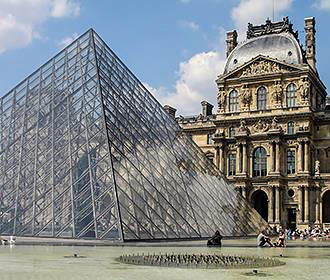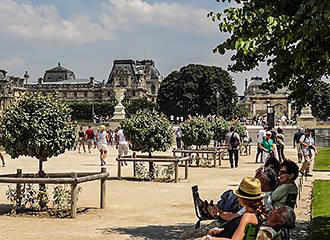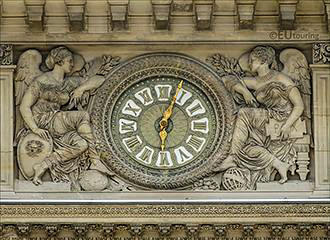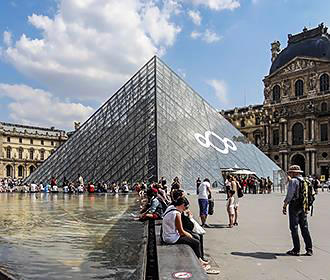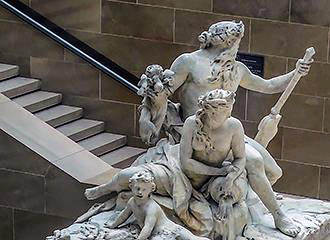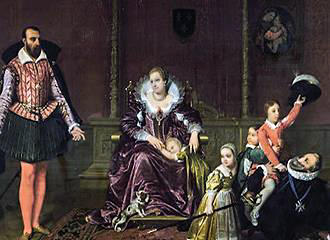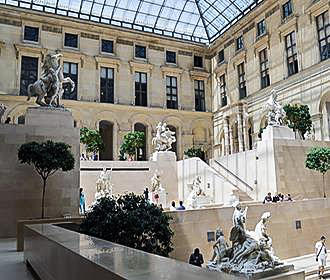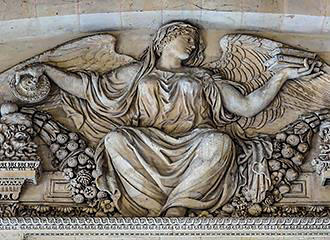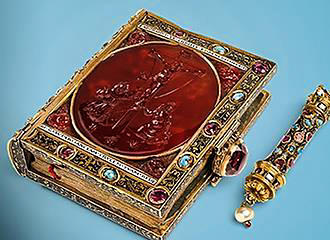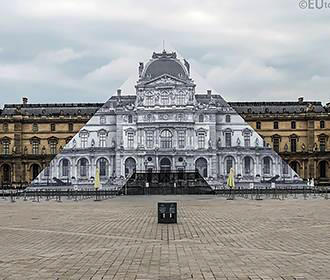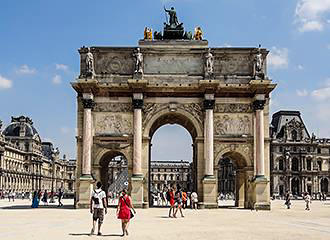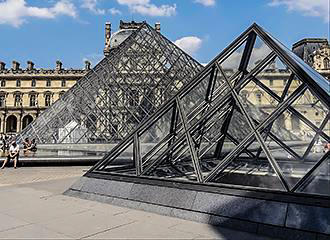Famous Paris Musee du Louvre history
The first real beginnings of what was to become the most famous museum in the world goes way back to the 1600s through to today, turning into the world-famous Paris Musee du Louvre that has become the most visited of all Paris museums due to its unrivalled art collections.
Because the Louvre went from a fortress to palace and has such a fascinating history with the different building and construction works that took place over the centuries, there were also many different galleries and different sections installed over the years. They have been called different names and have grown over the centuries to what we know as the Paris Musee du Louvre Museum today.
Fortunately the rich history of the Louvre from fortress to Palace still remains, plus much of this splendour and fabulous architecture can still been seen in all its glory today, but let's get back to the Musee du Louvre history.
Musee du Louvre history the beginnings
It all started after the Louvre Palace had been abandoned for the Chateau Versailles and even though the renovations and continued construction was not fully complete, in 1692 King Louis XIV gave the orders that a gallery of antique sculpture was to be created in the Salle des Caryatides.
Yet the first major decisions for a museum at The Louvre came in 1791 when the National Assembly decided that The Louvre and the Tuileries Palace were to be the national place for the King and for grouping together all the different monuments of the science and arts.
Musee du Louvre history its opening
At the time when the museum first opened its doors in the August of 1793, it was called the Musee Central des Arts and only opened at weekends, with admission being free, priority admission was given to artists over the general public.
At the time of this Paris museum opening, there were mainly paintings that had been obtained from French royalty and aristocrats, who no longer resided in France, and these were displayed within the Salon Carre and the Grande Galerie.
However, after the French Revolution, the collections ending up getting enlarged rather quickly and spread to other apartments and when Napoleon Bonaparte I came to power he enriched the collection dramatically from his conquests.
The ground floor of the Petite Galerie, which had been home to the apartments for Anne of Austria, now held marble sculptures and statues that were too heavy to be placed on the upper floor.
This part of the museum was inaugurated by Napoleon I and his wife Josephine in November 1800, and was named the Musee des Antiques. It was here that the public could come and admire different pieces from the Vatican and Florence along with collections from the monarchy.
Dominique Vivant Denon, who was an artist, painter and archaeologist, always supported Napoleon Bonaparte and obtained many different paintings and artefacts from his travels that were also incorporated into the Musee du Louvre. When he was appointed the director of the museum in 1802, he changed its name to the Musee Napoleon in 1803, and even a bust of Lorenzo Bartolini was installed over the entrance door to the museum.
In fact, there were also antique guilded horses that had been stolen from the Saint Marks cathedral and square in Venice by Napoleon, and it was Dominique Vivant Denon who initiated their placement in Paris on top of the Arc du Triomphe du Carrousel, which is the triumphal arch Napoleon had constructed located in the Tuileries Gardens in front of the Louvre.
But after the defeat of Napoleon Bonaparte at the Battle of Waterloo and his imprisonment on Saint Helena island where he died, a lot of the original art works and artefacts were reclaimed by the different countries, and the original statues on the Arc de Triomphe du Carrousel were returned.
Musee du Louvre history next stages
It was not until 1824 that the next stage in the progression of the Paris Musee du Louvre museum happened. Located on the ground floor of the west wing of the Cour Carree between the Pavillon de l’Horloge and the Beauvais wing, a museum displaying sculptures from the Musee des Monuments Francais and from the Chateau Versailles was created in the Galerie d’Angouleme.
Jean-Francois Champollion was the founder of modern scientific Egyptology as he had discovered the principle of hieroglyphic writing back in 1822, and after overseeing the opening of an Egyptian museum in Turin, Italy, he then became the curator for a new Egyptian department at the Musee du Louvre.
This part of the museum known as the department of Egyptian antiquities was officially inaugurated in the May of 1826. Next came the Musee Charles X in 1827, which was located on the first floor of the south wing of the Cour Carree and included ancient bronzes, Medieval and Renaissance decorative arts, plus the ceiling of this area was decorated with paintings from reputed artists of the time.
Yet later in the same year, the Musee de la Marine was installed into the north wing of the Cour Carree on the first floor, then it was transferred to a larger space on the second floor, which is where it remained until 1943. However, the Musee de la Marine was growing too large and got its own dedicated museum at the Palais de la Chaillot, located at the Trocadero Gardens, close to the Eiffel Tower, which is where it still remains today.
Under the reign of King Louis Philippe, a new Spanish gallery was installed into the Louvre during 1837 and 1838, and this was very unusual at the time, as art works from Spain were very rarely seen in France before this time. However, they stopped being exhibited within the Paris Musee du Louvre a few years later and were then all sold in London, England in 1853.
During 1847, the very first Assyrian art museum was installed within the north wing of the Cour Carree and this was opened to the public in 1849. It was because of the fascination that people had with art and the culture of different countries, that a year later in 1850 the Musee Mexicain or Mexican Museum, along with the Algerian and ethnographic museums were created.
Many of you will also know that it is not just the works of art placed within the Musee du Louvre Museum that are such a tourist attraction in Paris, but it is the impressive architecture and paintings that are to be found within the building itself.
Eugene Delecroix was one such artist, painter and muralist that completed one of the ceilings in a gallery at the Louvre in 1851. However, you might also like to know that there is a Paris museum called the Musee Delacroix that is dedicated specifically to him and his works over the years.
Then in 1852 the Musee des Souverains was opened by Louis-Napoleon, which is within the Colonnade and this particular museum was dedicated to the French royal dynasties from Childeric I through to Napoleon I, which enhanced the collections at the Louvre dramatically.
There was another major addition added to the Louvre during the Second Empire when over 11,000 paintings, objet d’art, sculptures and antiquities were acquisitioned from the Marquis Campana, becoming called the Musee Napoleon III, which was then inaugurated in 1863.
Musee du Louvre history of the Grande Louvre Museum
Unfortunately, as you may have read on history of the Louvre from fortress to palace, the Tuileries Palace was destroyed by fire during the 1871 Paris Commune. However, this also marked the beginnings of the Grande Louvre Museum in Paris as we know it today.
This is because rather than being reconstructed, the Palais des Tuileries was completely demolished, which led to Musee du Louvre becoming a place of culture, rather than the seat of power and a royal residence.
So, with additional construction work being undertaken on the Louvre, this meant that there was more space that could be dedicated to the museum and after excavations had taken place in Susa in Iran, a new display was created in 1888 that enhanced the department of near eastern antiquities.
Originally a collection of decorative arts was held within the Palais de l’Industrie and the Pavillon de Flore at one end of the former Tuileries Palace, but in 1905 the Musee des Arts Decoratifs was inaugurated within the Rue de Rivoli wing of the Louvre between the Pavillon de Flore and the recently rebuilt Pavillon de Marson the other end of the former palace.
Today, there are actually three museums held within the Rohan and Marsan wings of the Paris Musee du Louvre Museum on the Rue de Rivoli, which are called the Musee des Arts Decoratifs, the Musee de la Mode et du Textile and the Musee de la Publicite. Yet we would like to point out that these Paris museums are now run separately to the Musee du Louvre and therefore are not incorporated within the price for a visit to the Louvre museum.
But it was the year 1922 that saw the opening of the first dedicated Islamic gallery at the Paris Musee du Louvre which was after the original collection was greatly enhanced by the Baroness Delort de Gleon, and these were all now compiled together in the Pavillon de l’Horloge.
Musee du Louvre history next stage the development
A plan was then put in place in 1926 by Henri Verne who was the director of national museums in France, which would greatly improve the exhibition space within the Paris Musee du Louvre and the ambitious was work started in 1930. Initially the Cour du Sphinx was given a glazed roof to house antique sculptures. The Cour Carree was opened with objets d’art and paintings, along with new wings that were opened within the Pavillon du Flore.
Improvements continued and the galleries that held the Egyptian and Near Eastern Antiquities were also renovated, yet in 1939 World War II broke out and virtually every item, except anything too large, was removed and placed initially within the Chateau Chambord castle located in the Loire Valley within the Centre Region.
However, many items like the La Joconde, or as many of you will know it, the Mona Lisa by Leonardo da Vinci, were moved to different chateaux and castles in France several different times during the war in an effort to make sure these remained safe.
Even though there were only plaster casts and some large statues remaining at the Louvre, it reopened as a museum in 1940 during World War II, and improvements continued throughout the war.
The next stage of the ambitious plan was to re-organise lots of the different art collections and the Asian collections were moved to the Musee Guimet on the Place d’Iena in Paris, which again is where this remains today.
Then in 1947 the original games court within the Tuileries Gardens called the Jeu de Paume was officially opened as part of the Musee du Louvre museum, which was called the Musee de l’Impressionisme. However the space became too small to house the collection and they were transferred to the Musee d’Orsay on the opposite bank of the River Seine. Yet today, the Jeu de Paume is a separate museum that houses a museum of photography from the 19th century through to the 21th century.
Musee du Louvre history the Grand Louvre project
By the start of the 1980s, it was clear that the visitor experience needed to be improved with better displays and more amenities, so in the September of 1981 the French President at the time, Francois Mitterrand, announced the launch of the Grand Louvre project, which was to incorporate the museum as well as the Tuileries and Carrousel Gardens.
The modernisation and improvements for the museum were entrusted to the renowned architect Ieoh Ming Pei, who designed an entirely new entrance hub underneath the Cour Napoleon courtyard and added the large pyramid above.
Made out of glass and steel and standing over 21 metres in height this is the largest of the now famous pyramids, yet this is flanked by two smaller pyramids along with water features and fountains also being added, in addition to an inverted pyramid in the Carrousel du Louvre shopping centre.
There was a complete re-organisation of the exhibits within the Paris Musee du Louvre, with I M Pei also being instrumental in creating new exhibition spaces in the Richelieu wing, storage rooms, an auditorium and a shopping centre, which we mentioned above, and this made it possible for visitors to access all three completely different areas of the Musee du Louvre from one main reception and entry point.
The I M Pei pyramids were inaugurated on 30th March 1989, and although many were unsure or criticised the contrast between the old and new, it proved to be an instant success, with these becoming an icon of The Louvre and Paris known throughout the world.
Ieoh Ming Pei continued to help and advise on the Grand Louvre project and in 1993 the largest expansion in the Musee du Louvre history happened when the Richelieu wing was opened and glazed courtyards allowed for additional space to exhibit monumental sculptures, one being known as the Cour Marly.
Then by 1997 the Sackler wing was inaugurated along with the refurbishment of the Salle des Etats below the Cour Visconti to hold three new galleries of antique art works, with I M Pei still contributing to the project right through to 2016, but unfortunately in May 2019, just shortly after the 30th anniversary of the pyramids inauguration, Ieoh Ming Pei passed away at the age of 102.
But as you can no doubt tell, the Louvre Museum is an ongoing continual project to enrich its collections and the experience for the many millions of tourists that come to visit this famous Paris museum from all over the world, which has also more than doubled since the initial launch of The Grand Louvre Project.
In addition, they hold temporary exhibitions as well, which means whenever you are on holiday in Paris from one year to the next, there will always be something different to experience at the Paris Musee du Louvre.
